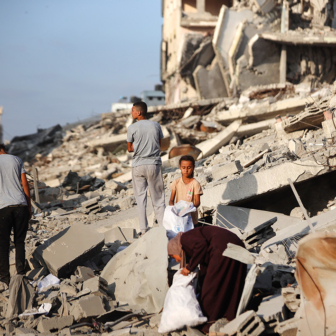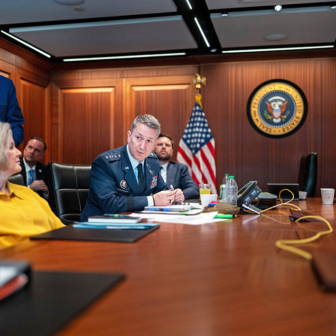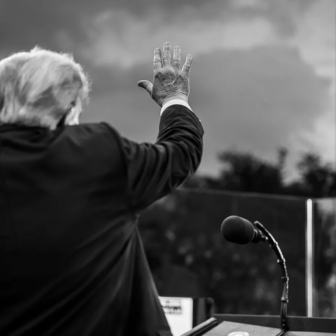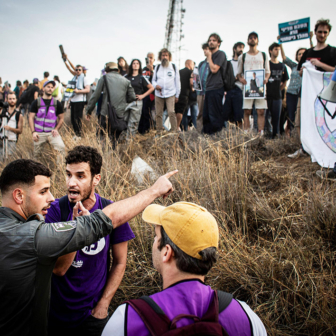WHEN ISRAEL withdrew the 9000-strong settler population from the Gaza Strip five years ago, hopes were renewed that normalisation was beginning after the five years of deadly violence that followed the breakdown of the 1993–2000 “Oslo” peace process. In New York, the United Nations commented that “the Palestinians have experienced the joy of the departure of the occupier” and “the Israelis are no longer saddled with the unrewarding, Sisyphus-like grind of securing the Gaza Strip.”
Voices in the neighbourhood were more pessimistic, even cynical. Writing in the Israeli newspaper Haaretz, Zvi Bar’el, a liberal political commentator, noted that “all the components of the potential [Gaza] explosion are yet to be neutralised – the highest population density in the world, terrible poverty, a huge collection of arms, and a radical leadership [Hamas].” The Egyptian newspaper Al-Ahram published a cartoon that depicted Ariel Sharon contemptuously tossing a lean bone labelled “Gaza” onto an outstretched plate held by the Palestinian president Mahmoud Abbas, who gazed longingly at a fat leg of lamb, labelled “West Bank,” grasped firmly in the Israeli prime minister’s other hand.
Five years on from 2005, the faint hopes aroused by Israel’s Gaza withdrawal have been cruelly shattered. Instead, Gaza has emerged as symbol and flashpoint of the morass that is post-Oslo and post–second intifada Israel–Palestine, of which internecine Palestinian warfare, Israel’s punitive “Operation Cast Lead” in December 2008–January 2009, and now the peace flotilla fiasco in the eastern Mediterranean are all symptoms.
Israel has long regarded the Gaza Strip as an unmanageable and dispensable liability. A few months before the first Palestinian intifada began in the Jebalya refugee camp, located at the Strip’s northern end, in December 1987, the Israel Defence Forces completed a classified study titled “The Gaza District Up to the Year 2000.” It was, in the words of the Israeli analysts Ze’ev Schiff and Ehud Ya’ari, “one of the grimmest documents ever submitted to the Israeli establishment.” The report warned that an exponentially rising population combined with acute land and water shortages amounted to “a human time-bomb ticking away at Israel’s ear.” In their study of the first intifada, published in 1989, Schiff and Ya’ari wrote that “the Gaza Strip is a cancer that will steadily drain the State of Israel” and predicted that “Israel will soon be on its knees begging all and sundry to do it the mercy of taking Gaza off its hands.”
That prognosis proved prescient. Over the first eight months of 1993, during the famous “back-channel” talks between Israeli and Palestine Liberation Organisation representatives in Norway, the first point of in-principle agreement concerned Israel’s disengagement from Gaza. Dennis Ross, the US special envoy to the Middle East from 1989 to 2001, has written in his memoirs that “in Israeli eyes, this was a promising beginning. The Israelis wanted out of Gaza.”
In 1994 the Strip’s maze of congested townships and claustrophobic refugee camps was duly turned over by Israel to the administration of Yasser Arafat’s Palestinian Authority, along with Jericho, a West Bank town in the Judean desert near the border with Jordan. Israel retained a significant portion of the Strip containing Jewish settlements, as well as control over roads linking those settlements to Israel. In 2005 Sharon took the seemingly revolutionary step of dismantling the settlements and relocating their inmates to Israel, in the face of strong protests by the settlers. Especially resistant were those in the large settlement bloc of Gush Katif, located in the south-western part of the Strip next to the teeming Palestinian areas of Rafah and Khan Yunis. Sharon defended his decision in pragmatic terms: “I am not prepared to accept the claim that leaving Gaza is the trampling of Zionism. It is in fact strengthening Zionism in areas that are much more important.” He specifically cited Jerusalem and its environs, the Galilee region of northern Israel (which has a large “Israeli Arab” population) and the Negev desert of southern Israel as the areas of high strategic priority, unlike Gaza, to the Jewish state.
It is thus more than a little ironic that Israel continues not just to bear, but also to aggravate through its own actions, the Sisyphus-like burden represented by Gaza. Fifty-four years ago, the Israel Defence Forces seized Gaza during the Suez conflict of 1956. Dr Haidar Abd al-Shafi, an eminent resident of the Strip, recalled that brief occupation many years later: “I remember Israel’s occupation of Gaza during the Suez invasion in 1956. It was clear that they were engaged in long-term planning, that they intended to stay. When the UN passed resolutions calling for withdrawal, France and Britain withdrew immediately from the canal area and Israel began to slowly withdraw from the parts of Sinai it had occupied. But they made no move to withdraw from Gaza, and when President Eisenhower sent a letter to [David] Ben-Gurion” – the Israeli prime minister at the time – “asking why Israel did not withdraw Ben-Gurion had the gall to not reply. But then Eisenhower wrote a second letter threatening sanctions, and Israel withdrew in one night. That night we went to bed to the noise of armoured cars roaming the streets, and woke up the next morning to find no trace of Israelis in the Strip. It took a president with a moral fibre to get them out.”
Alas, 2010 is not 1956, Obama – his virtues notwithstanding – is not Eisenhower, Netanyahu is definitely no Ben-Gurion, and Israel finds it seemingly impossible to extricate itself from the messy legacy of the long occupation of Gaza that commenced in June 1967. And Gaza’s inhabitants find Israeli occupation replaced by Israeli blockade.
The consistent harshness of Israeli operations aimed at Gaza, most notably in Operation Cast Lead but also apparent in the decision to interdict the activist flotilla sailing toward the Strip, may seem somewhat puzzling at first glance. Why react with such ferocity to the relative pinpricks inflicted by Qassam rocketry, and mostly on small towns like Sderot? Why risk a fresh round of global controversy and criticism by pouncing in waters on a flotilla of vessels with hundreds of people of different nationalities on board? But while the Israeli use of disproportionate force may not be justified, it can be explained.
To most Israelis, the elites and the citizenry alike, a Gaza Strip under Hamas control embodies in a concentrated microcosm the mixture of menaces that cumulatively constitute the “existential threat” to their state and society. The declaratory hostility of Hamas, a movement that enjoys the committed adherence of a very large minority of Palestinians, to the existence of Israel is one component of this existential syndrome; the unsettling physical proximity to Israel of the Hamas enclave in Gaza is another. But by themselves these two components would not add up to more than a major irritant to Israel’s sense of security.
What makes Hamas-controlled Gaza more than a neighbourhood nuisance is the movement’s links with Syria and (particularly) Iran. The hardline Hamas leader Khaled Meshaal lives in and operates from Damascus. The Islamic Jihad group, which has long been active in Gaza and currently enjoys a relatively fraternal relationship with Hamas, has a longstanding and close nexus with Iran’s military and intelligence apparatus. Israel has a simmering “northern front” where it faces a formidable adversary, Hezbollah, backed by Iran and also Syria. The Hamas-dominated enclave in Gaza represents a live “southern front” where the same constellation of anti-Israel forces coalesces. Nor can Hamas be chased away from Gaza – or Hezbollah from Lebanon – in the manner the PLO was evicted from Jordan in 1970 and Lebanon in 1982.
It is this calculus of interlinked threats that fortifies the Israeli siege mentality. That mentality is manifested in the hammer-and-tongs operations seen in Lebanon in 2006 and Gaza in 2008–09 and 2010 (and indeed in the assassinations of Imad Mughniyeh in Damascus in early 2008 and Mahmoud al-Mabhouh in Dubai in early 2010). The Gaza imbroglio and its periodic eruptions are especially uncomfortable for the authoritarian regime of Egypt, whose suspicion of Hamas – an offshoot of Egypt’s Muslim Brotherhood movement – is matched if not surpassed by the Egyptian public’s dislike of Israel’s aggressive behaviour.
In January 1995, a suicide bombing conducted inside Israel by the Islamic Jihad group killed twenty Israeli soldiers and one civilian. In a nationally televised address after the incident, Prime Minister Yitzhak Rabin grimly promised to “take Gaza out of Tel Aviv” and declared that this would be achieved through “a separation between us and them,” to be negotiated with Yasser Arafat. The promise to liberate the faux Mediterranean Europe of Tel Aviv from the fanaticism and violence of Gaza underlined the mixture of contempt and fear with which the typical Israeli views the festering cauldron of the Strip. And this was fifteen years ago, well before the rise of Hamas to political and strategic prominence.
THE PALESTINIANS, meanwhile, are a nation divided. The strongman-centric Palestinian Authority regime of Yasser Arafat was past its sell-by date significantly before Arafat’s death. In the post-Arafat phase Palestinian politics has, instead of experiencing a transition to a two-party system based on mutual tolerance and power-sharing between Fatah and Hamas, experienced its opposite: a bitter rift between the two major Palestinian political formations, a Hamas power-grab in Gaza and Fatah repression of Hamas supporters in the West Bank. Arafat’s legacy of corrupt, clique-based governance has of course contributed much to the unseemly fracas into which Palestinian politics has degenerated after his demise. But so has Arafat’s absence from the scene. The Palestinian polity has had trouble evolving beyond the situation in which Arafat, for all his flaws and misdemeanours, provided a focal point.
The decline of Fatah and the ascendancy of Hamas are due, above all, to one factor – the catastrophic failure of the 1993–2000 peace process. Hamas rose almost literally from the ruins of Oslo and the embers of the second intifada. As the most significant Palestinian faction opposed to and excluded from the Oslo process, Hamas stood to gain the most once most Palestinians, in the words of the Israeli observer Ron Pundak, “came to the conclusion that Israel did not in fact want to end the occupation” and became convinced that their established leadership had been tricked into a “barren process” and “historical trap.”
And gain Hamas did. Through 2005 it won a string of victories in Palestinian local elections. And not just in the Gaza Strip, the cradle and stronghold of the movement; it also won resoundingly in West Bank cities like Nablus and towns like Qalqiliya. These local triumphs were the precursor to its landslide victory in the Palestinian parliamentary election of early 2006, when Hamas took an absolute majority – seventy-four out of 132 – of the legislature’s seats. It was striking that Hamas won handsomely not only in places where it is known to have a strong base, such as religious-minded Hebron, but also in Ramallah, regarded as a bastion of secular Palestinian nationalists and leftists.
The lesson of this history is that the “problem” represented by Gaza – and Hamas – cannot be tackled in isolation, but only through a serious, sustained renewal of an Israeli–Palestinian peace process. That is a tall order. The constellation of mutually reinforcing obstacles is quite daunting.
The Palestinian polity is hopelessly disunited. Yet it is difficult to deny the argument made by Hamas specialists Beverley Milton-Edwards and Alastair Crooke that “a meaningful and inclusive Palestinian national unity is necessary for a negotiated peace” between Israel and the Palestinians. As a political actor Hamas is too significant to be ignored, marginalised or suppressed, and at the same time the “inclusion” of Hamas is fraught with complications. The possibility of indirect inclusion via the good offices of a third-party intermediary such as Turkey has receded for the time being after the flotilla fiasco and the sharp downturn in Turkish–Israeli relations. It is certain, however, that the formulaic distinction made by many influential Israelis and Americans between (acceptable) Fatah “moderates” and (unacceptable) Hamas “extremists” is a recipe for continuing deadlock.
The problem of Palestinian disunity is reinforced by the very pronounced rightward shift of the centre of gravity of Israel’s polity since the early years of the Oslo process. This shift is exemplified among many other developments by the progression from Shimon Peres to Tzipi Livni and then to Avigdor Lieberman in Israel’s foreign ministry. As for Binyamin Netanyahu, it remains to be established whether he has evolved since his previous term as Israel’s prime minister (1996–99), when he was privately described by a British ambassador to Tel Aviv as “a drunk who lurches from one lamp-post to the next.” Sixteen summers ago, it seemed feasible that Rabin and Arafat – both towering figures amongst their own peoples – would be able to deliver a lasting Israeli–Palestinian rapprochement. Harbouring such hopes with Netanyahu and Abu Mazen – lightweights presiding over deeply factionalised polities – would stretch the imagination of a fantasist. The demoralisation and disarray on the Israeli left looks unlikely to abate in the near future, and the appearance of Marwan Barghouti as a Palestinian Gerry Adams remains just a gleam on the horizon.
The geopolitics of the wider region is also challenging. The Israel–Syria antagonism cannot be mended without a resolution of the Golan Heights issue. Lebanon’s internal equilibrium is fragile, and the summer 2006 conflict between Hezbollah and Israel a recent, ominous memory. The paranoia – partly feigned but partly real – among Israel’s political and security establishments about Iran’s capabilities and intentions is an additional source of tension and intransigence. The seriousness of the “Iran factor” has been aggravated by Iran’s internal, and unresolved, turmoil since the disputed presidential election of June 2009. The image of Iranian aid ships attempting to run Israel’s Gaza blockade is exactly the kind of picture the world’s television screens can do without.
“Only a dispassionate, fair and impartial arbiter,” according to the scholar Rashid Khalidi, “can help bring the two sides to mutually acceptable terms.” He believes that “if there is to be peace between Palestinians and Israelis the United States must begin to act in this fashion, or it must allow another [third] party to do so.”
There is clearly no plausible third party other than the United States that could possibly play a substantive role to disentangle this stalemate. At the same time, the limits to American influence with Israel became apparent in March 2010, when the United States fired a calculated – if only verbal – warning shot across Israel’s bows after an Israeli announcement of further housing for Israelis in East Jerusalem coincided with Vice-President Biden’s visit to the Jewish state and the West Bank, and the Israeli government reacted in the manner of a cornered bulldog. Will George Mitchell, the US special envoy for the Middle East – a far bigger brief than the one he creditably handled in the second half of the 1990s as the US special envoy for Northern Ireland – be able to make a difference? Can the Obama administration, disengaging from Iraq but bogged down in Afghanistan, rise to the challenge? Time will surely tell, but the portents are not promising. •




